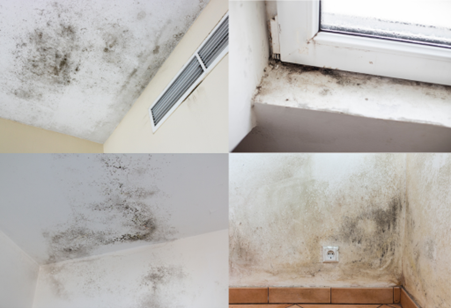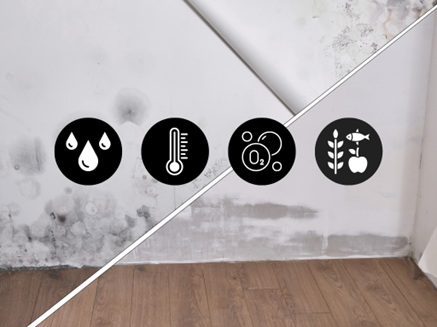Guarding Against Mould: Causes, Health Implications, and Comprehensive Mitigation Approaches
Back to List
Mould is a diverse group of organisms that includes thousands of different species. It can be found everywhere, indoors, and outdoors. Mould reproduces by producing tiny spores that are released into the air. These spores can easily spread and settle on surfaces where they can grow under suitable conditions.
What factors causing the growth of mould?
Mould growth necessitates four primary factors: moisture, an optimal temperature within the range of 25°C to 30°C, oxygen, and an organic food source. Common organic materials that serve as food sources for mould include wood, paper, fabric, and drywall. Inadequate ventilation in an environment or building can exacerbate mould presence by creating an excess of moisture.
Why breathing in mould spores can cause health issues?
- Allergic Reactions: Mould spores can trigger allergic reactions in some people, like other common allergens. Symptoms may include sneezing, runny or stuffy nose, itchy or watery eyes, coughing, wheezing, and skin irritation.
- Asthma Exacerbation: Individuals with asthma may experience worsening of their symptoms when exposed to mould. This can lead to coughing, wheezing, shortness of breath, chest tightness, and increased frequency or severity of asthma attacks.
- Respiratory Issues: Prolonged exposure to mould spores can irritate the respiratory system, causing throat irritation, coughing, congestion, and difficulty breathing. In some cases, it may lead to the development of respiratory infections.
- Hypersensitivity Pneumonitis: This is a rare condition that can occur in susceptible individuals who inhale significant amounts of mould spores. It causes inflammation of the lungs, leading to symptoms such as cough, shortness of breath, fever, and fatigue.

Common Household Methods of Controlling Mould
Here are some practical approaches to control mould growth and maintain a mould-free living space:
- Opening Windows for Ventilation: Ventilating by opening windows can effectively inhibit the growth of mould spores by allowing moisture to escape to the outside environment. This open ventilation allows patches of dampness to naturally dry out, thereby discouraging mould growth.
- Cleaning Affected Areas with Chemical Bleach: Another common method is to clean the affected areas with chemical bleach to remove mould stains. However, it's important to note that mould may potentially return after cleaning.
- Applying Anti-Mould Paint to Affected Areas: Anti-mould paint can be applied to affected areas as it contains properties that inhibit mould growth. It's important to consider that the effects of this paint may not be permanent, and mould may reappear after a certain period.
Professional Mould Mitigation Programme
While the aforementioned methods are somewhat effective in preventing mould growth, there is a high chance that mould will reappear over time. The most effective approach to control mould growth is through a comprehensive strategy that addresses all aspects of inhibiting mould growth.
This approach is highly recommended in cases where mould infestation is excessive and requires immediate remediation. A professional mould mitigation program should encompass the following key steps:
- Site Inspection: Conduct a thorough assessment to determine the spread and type of mould present. Further analysis of mould samples in a lab can provide critical information about the mould.
- Site Investigation: Identify the root cause of the mould, such as high relative humidity and condensation, creating an environment conducive to mould growth.
- Treatment of Affected Surfaces: Implement effective treatment measures on the mould-affected surfaces, including scraping off the affected areas and applying specialized paint and sealant to prevent future mould growth.
- Air Treatment: Treat the air in the immediate vicinity of the mould-affected area through air fumigation to eliminate mould spores that could contribute to further spread.
- Addressing Humidity Issues: Rectify the root cause of high relative humidity and condensation, often requiring a comprehensive inspection of the HVAC system. Addressing issues like duct works leaking cold air, oversizing of HVAC systems, proximity to cold areas (e.g., server rooms), and poor ventilation systems is essential. These issues can be resolved with appropriate recommendations from HVAC specialists.
- Post-Site Inspection: Conduct a follow-up inspection to confirm the effectiveness and proper implementation of the remediation program.
Daikin offers professional mould mitigation programme tailored to meet your specific needs. Our expertise in HVAC design, coupled with our growing proficiency in Indoor Air Quality, allows us to provide a holistic approach in our solutions, blending a unique ‘HVAC & IAQ’ consideration to perfect the air.
-
Read more
Daikin’s R32 Refrigerant Can Lower Your Electricity Consumption
-
Read more
Poised For The Rise Of Green Consumerism – Meeting Consumer’s New Expectations
-
Read more
Things you never dreamed that your air-con can do
-
Read more
Importance of proper Air Con Servicing
-
Read more
What is Smart Home?
